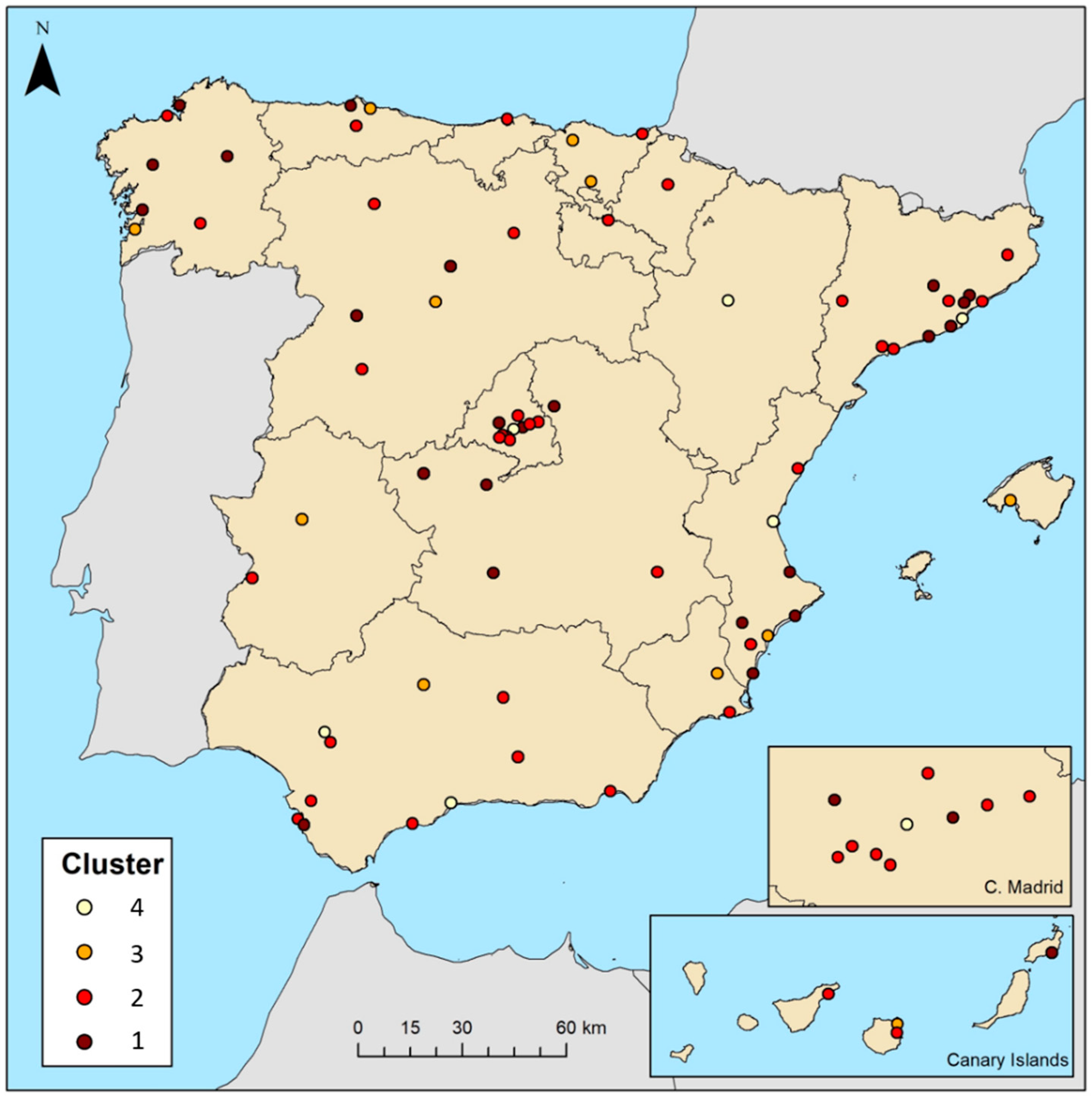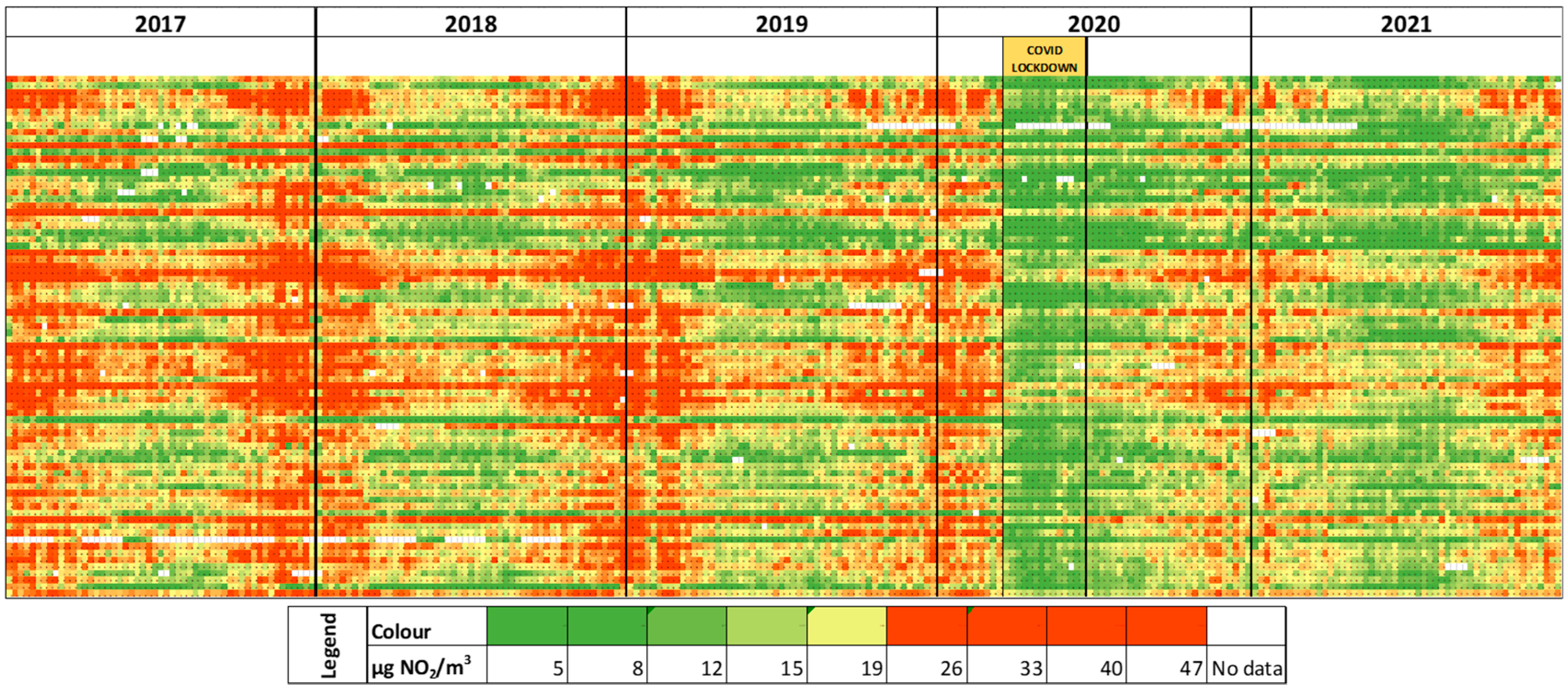Analysis of the COVID-19 Lockdown’s Impact on Air Quality in the Larger Cities of Spain
Abstract
:1. Introduction
2. Materials and Methods
2.1. Air Quality Monitoring Network
2.2. Spanish COVID-19 Restrictions Per Period
- The “total lockdown” measure affected all movement of people, except in critical or specific situations, such as those involving emergency vehicles (ambulances, police, firefighters, etc.), public services (public transportation, postal mail, etc.), and other minimal services that were highly necessary (hospitals, medicine manufacturing, etc.).
- The “flexible lockdown” measure had similar restrictions in terms of mobility, but allowed activity in further sectors and services (public administration services, cleaning services, etc.).
- “Phases 0 to 3” involved the progressive reincorporation of the service and productive sectors of society that were not considered highly necessary (education, leisure, technology centers, etc.).
- “New normality” is the situation representing the absence of such severe and generalized limitations. However, economic restrictions in different activity sectors (the activity of restaurants and bars was limited; depending on the number of infections, a night curfew was established) or the so called “perimetral locks” in certain municipalities led to eventual disruptions in normal activity and mobility.
2.3. Monitored Cities
- Cluster 1 (between 50,000 and 100,000 inhabitants): 25 cities;
- Cluster 2 (between 100,000 and 250,000 inhabitants): 37 cities;
- Cluster 3 (between 250,000 and 500,000 inhabitants): 10 cities;
- Cluster 4: (more than 500,000 inhabitants): 6 cities.
2.4. Analysis of Impact
- The pre-COVID-19 years (2017–2019), pandemic year (2020), and post-COVID-19 year (2021).
- The different clusters in the different periods analyzed. This allowed the evaluation of the differences in the impact of the COVID-19 restrictions on the air quality according to city size, as well as the identification of differences in recovery during the post-COVID-19 period.
- The months of the different monitored periods. This allowed a detailed evaluation of which months had significant differences between the periods analyzed.
3. Results and Discussion
3.1. Air Quality Analysis
3.2. Impact of the COVID-19 Lockdown
3.2.1. Variations in Air Quality Levels between Different Monitored Periods
3.2.2. Variations in Air Quality Levels between the Clusters and Monitored Periods
3.2.3. Variations in Air Quality Levels between Months
4. Conclusions
Supplementary Materials
Author Contributions
Funding
Data Availability Statement
Acknowledgments
Conflicts of Interest
References
- Lelieveld, J.; Klingmüller, K.; Pozzer, A.; Pöschl, U.; Fnais, M.; Daiber, A.; Münzel, T. Cardiovascular disease burden from ambient air pollution in Europe reassessed using novel hazard ratio functions. Eur. Heart J. 2019, 40, 1590–1596. [Google Scholar] [CrossRef] [PubMed] [Green Version]
- American Thoracic Society (ATC). What constitutes an adverse health effect of air pollution? Official statement of the American Thoracic Society. Am. J. Respir. Crit. Care Med. 2000, 161, 665–673. [Google Scholar] [CrossRef] [Green Version]
- European Environmental Agency. Air Quality in Europe—2019 Report. Report Nº 10/2019. Available online: https://www.eea.europa.eu/publications/air-quality-in-europe-2019 (accessed on 7 April 2022).
- Guttikunda, S.K.; Nishadh, K.A.; Jawahar, P. Air pollution knowledge assessments (APnA) for 20 Indian cities. Urban Clim. 2019, 27, 124–141. [Google Scholar] [CrossRef]
- Costa, S.; Ferreira, J.; Silveira, C.; Costa, C.; Lopes, D.; Relvas, H.; Borrego, C.; Roebeling, P.; Miranda, A.I.; Teixeira, J.P. Integrating Health on Air Quality Assessment—Review Report on Health Risks of Two Major European Outdoor Air Pollutants: PM and NO2. J. Toxicol. Environ. Health 2014, 17, 307–340. [Google Scholar] [CrossRef] [PubMed]
- European Commission. Directive 2008/50/EC on Ambient Air Quality and Cleaner Air for Europe. European Parliament and of the Council. 21 May 2008. Available online: https://www.eea.europa.eu/policy-documents/directive-2008-50-ec-of (accessed on 7 April 2022).
- Carnell, E.; Vieno, M.; Vardoulakis, S.; Beck, R.; Heaviside, C.; Tomlinson, S.; Dragosits, U.; Heal, M.R.; Reis, S. Modelling public health improvements as a result of air pollution control policies in the UK over four decades—1970 to 2010. Environ. Res. Lett. 2019, 14, 074001. [Google Scholar] [CrossRef]
- Committee on the Medical Effects of Air Pollutants (COMEAP). Review of the UK Air Quality Index: A Report by the Committee on the Medical Effects of Air Pollutants. Didcot: Health Protection Agency. 2011. Available online: www.hpa.org.uk/webc/HPAwebFile/HPAweb_C/1317137023144 (accessed on 22 March 2014).
- World Health Organization. WHO Global Air Quality Guidelines. Particulate Matter (PM2.5 and PM10), Ozone, Nitrogen Dioxide, Sulphur Dioxide and Carbon Monoxide; World Health Organization: Geneva, Switzerland, 2021; Available online: https://www.who.int/publications/i/item/9789240034228 (accessed on 7 April 2022).
- Ching, J.; Kajino, M. Rethinking Air Quality and Climate Change after COVID-19. Int. J. Environ. Res. Public Health 2020, 17, 5167. [Google Scholar] [CrossRef] [PubMed]
- Hu, M.; Chen, Z.; Cui, H.; Wang, T.; Zhang, C.; Yun, K. Air pollution and critical air pollutant assessment during and after COVID-19 lockdowns: Evidence from pandemic hotspots in China, the Republic of Korea, Japan, and India. Atmos. Pollut. Res. 2020, 12, 316–329. [Google Scholar] [CrossRef] [PubMed]
- Rossi, R.; Ceccato, R.; Gastaldi, M. Effect of road traffic on air pollution. Experimental evidence from COVID-19 lockdown. Sustainability 2020, 12, 8984. [Google Scholar] [CrossRef]
- Meteorology Statal Agency (AEMET). Available online: http://www.aemet.es/en/serviciosclimaticos/datosclimatologicos/valoresclimatologicos (accessed on 7 April 2022).
- Roberts–Semple, D.; Song, F.; Gao, Y. Seasonal characteristics of ambient nitrogen oxides and ground–level ozone in metropolitan northeastern New Jersey. Atmos. Pollut. Res. 2012, 3, 247–257. [Google Scholar] [CrossRef] [Green Version]
- Sadanaga, Y.; Shibata, S.; Hamana, M.; Takenaka, N.; Bandow, H. Weekday/weekend difference of ozone and its precursors in urban areas of Japan, focusing on nitrogen oxides and hydrocarbons. Atmos. Environ. 2008, 42, 4708–4723. [Google Scholar] [CrossRef]
- Geddes, J.A.; Murphy, J.G.; Wang, D.K. Long term changes in nitrogen oxides and volatile organic compounds in Toronto and the challenges facing local ozone control. Atmos. Environ. 2009, 43, 3407–3415. [Google Scholar] [CrossRef]


| Strategy Stage | Measure | Period | |
|---|---|---|---|
| COVID-19 LOCKDOWN | Resilience | Total lockdown | 15 March–26 April 2020 |
| Flexible lockdown | 27 April–3 May 2020 | ||
| Recovery | Phase 0 | 4–17 May 2020 | |
| Phase 1 | 18–31 May 2020 | ||
| Phase 2 | 1–14 June 2020 | ||
| Phase 3 | 15–21 June 2020 | ||
| New normality | 22 June 2020–present |
| Annual Average | Period Average (2017–2021) | Pre-COVID-19 Period (2017–2020) | COVID-19 Lockdown (March–May 2020) | |||||
|---|---|---|---|---|---|---|---|---|
| Cluster | 2017 | 2018 | 2019 | 2020 | 2021 | |||
| 1 | 20.2 | 17.8 | 17.1 | 13.3 | 13.7 | 16.4 | 18.4 | 7.4 |
| 2 | 24.5 | 22.1 | 21.4 | 16.9 | 17.0 | 20.4 | 22.7 | 9.6 |
| 3 | 26.1 | 25.5 | 23.6 | 17.9 | 17.1 | 22.0 | 25.1 | 10.8 |
| 4 | 33.1 | 29.3 | 27.8 | 21.8 | 21.4 | 26.7 | 30.1 | 12.8 |
| Total Average | 24.0 | 21.7 | 20.8 | 16.3 | 16.3 | 19.8 | 22.2 | 9.3 |
| Are There Significant Differences? | ||
|---|---|---|
| Period Analyzed | Yes | No |
| 2017, 2018, 2019, 2020, 2021, pre-COVID-19 average, and COVID-19 lockdown average | X | |
| 2017, 2018, 2019, and pre-COVID-19 average | X | |
| 2017, 2018, and 2019 | X | |
| 2019 and 2020 | X | |
| 2019 and 2021 | X | |
| 2020 and COVID-19 lockdown average | X | |
| 2020 and 2021 | X | |
| 2021 and COVID-19 lockdown average | X | |
| Are There Significant Differences between the Same Months of These Periods? | ||||
|---|---|---|---|---|
| 2017, 2018, 2019, 2020, and 2021 | 2019 and 2020 | 2020 and 2021 | 2019 and 2021 | |
| January | Yes | No | Yes | Yes |
| February | Yes | No | Yes | Yes |
| March 1 | Yes | Yes | Yes | Yes |
| April 1 | Yes | Yes | Yes | Yes |
| May 1 | Yes | Yes | Yes | Yes |
| June 1 | Yes | Yes | No | Yes |
| July | Yes | Yes | No | Yes |
| August | Yes | Yes | No | Yes |
| September | Yes | Yes | No | Yes |
| October | Yes | Yes | No | No |
| November | Yes | No | No | No |
| December 2 | Yes | Yes | Yes | No |
Publisher’s Note: MDPI stays neutral with regard to jurisdictional claims in published maps and institutional affiliations. |
© 2022 by the authors. Licensee MDPI, Basel, Switzerland. This article is an open access article distributed under the terms and conditions of the Creative Commons Attribution (CC BY) license (https://creativecommons.org/licenses/by/4.0/).
Share and Cite
Lorenzo-Sáez, E.; Coll-Aliaga, E.; Oliver-Villanueva, J.-V.; Prieto del Campo, F.; Lerma-Arce, V. Analysis of the COVID-19 Lockdown’s Impact on Air Quality in the Larger Cities of Spain. Sustainability 2022, 14, 5613. https://doi.org/10.3390/su14095613
Lorenzo-Sáez E, Coll-Aliaga E, Oliver-Villanueva J-V, Prieto del Campo F, Lerma-Arce V. Analysis of the COVID-19 Lockdown’s Impact on Air Quality in the Larger Cities of Spain. Sustainability. 2022; 14(9):5613. https://doi.org/10.3390/su14095613
Chicago/Turabian StyleLorenzo-Sáez, Edgar, Eloína Coll-Aliaga, Jose-Vicente Oliver-Villanueva, Fernando Prieto del Campo, and Victoria Lerma-Arce. 2022. "Analysis of the COVID-19 Lockdown’s Impact on Air Quality in the Larger Cities of Spain" Sustainability 14, no. 9: 5613. https://doi.org/10.3390/su14095613
APA StyleLorenzo-Sáez, E., Coll-Aliaga, E., Oliver-Villanueva, J.-V., Prieto del Campo, F., & Lerma-Arce, V. (2022). Analysis of the COVID-19 Lockdown’s Impact on Air Quality in the Larger Cities of Spain. Sustainability, 14(9), 5613. https://doi.org/10.3390/su14095613






